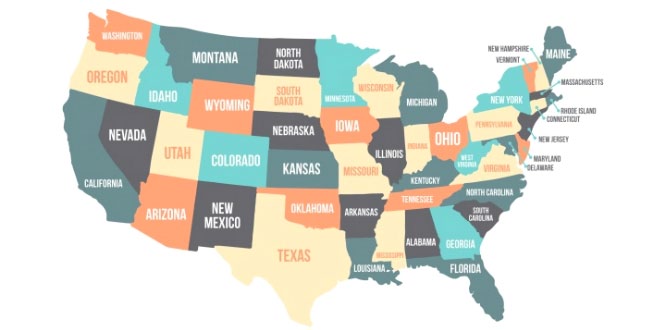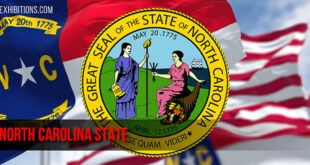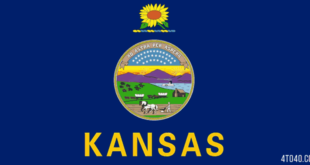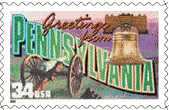 Pennsylvania State has played a leading role in the nation’s development. The First CONTINENTAL CONGRESS met in Philadelphia, and the Declaration of Independence was signed there. In the 19th century Pennsylvania became a major industrial state of the nation, but in recent years it has faced slowing industrial growth and population decline.
Pennsylvania State has played a leading role in the nation’s development. The First CONTINENTAL CONGRESS met in Philadelphia, and the Declaration of Independence was signed there. In the 19th century Pennsylvania became a major industrial state of the nation, but in recent years it has faced slowing industrial growth and population decline.
Pennsylvania is known as the Quaker State or the Keystone State. The latter name suggests its location along the arch of the 13 original states.
Pennsylvania State: Land & Resources
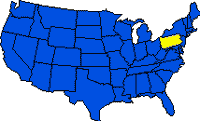 Nearly all of the topographic features common to the eastern United States are found in Pennsylvania. Along the DELAWARE RIVER in southeastern Pennsylvania is a narrow strip of the Atlantic Coastal Plain. This area is characteristically low and flat. From the Coastal Plain westward, the Piedmont Lowlands slope upward to a maximum elevation of about 150 m (500 ft) at the base of the Blue Mountains. Where the Coastal Plain borders the higher land to the west, hard rock and steeper slopes mark the FALL LINE. The Blue Mountains are rugged discontinuous highlands that extend from northeast to south central Pennsylvania. South Mountain is the northernmost point.
Nearly all of the topographic features common to the eastern United States are found in Pennsylvania. Along the DELAWARE RIVER in southeastern Pennsylvania is a narrow strip of the Atlantic Coastal Plain. This area is characteristically low and flat. From the Coastal Plain westward, the Piedmont Lowlands slope upward to a maximum elevation of about 150 m (500 ft) at the base of the Blue Mountains. Where the Coastal Plain borders the higher land to the west, hard rock and steeper slopes mark the FALL LINE. The Blue Mountains are rugged discontinuous highlands that extend from northeast to south central Pennsylvania. South Mountain is the northernmost point.
To the west of the Blue Mountains is the Great Valley, which extends beyond Pennsylvania through New Jersey and Virginia. The Ridge and Valley Province, about 70 km (40 mi) wide, extends in a northeast-to-southwest direction to the north and west of the Great Valley. Its parallel ridges and valleys are the result of tectonic folding. The ridges rise to an elevation of approximately 490 to 610 m (1,600 to 2,000 ft) above sea level, and often 150 to 300 m (500 to 1,000 ft) above the intermontane valleys.
Adjoining the Ridge and Valley Province on the west and north is the Appalachian or Allegheny Plateau, which covers more than half the state. This region has been highly dissected and is now rugged hill country. Steep slopes predominate, but some gently sloping or level plateau remnants can be found throughout the area. Whereas a trellis drainage pattern is found in the Ridge and Valley, the Appalachian Plateau has an elaborate dendritic pattern with the streams repeatedly branching headward and virtually covering the region. The plateau contains the highest elevations in Pennsylvania, including Mount Davis, 979 m (3,213 ft), the highest summit. The high eastern edge of the plateau is known as the Allegheny Front. In the northwest is the narrow Erie Lake Plain, part of the Central Lowlands.
The rocks in Pennsylvania vary from young sedimentary rocks to very ancient complex rocks. The Atlantic Coastal Plain is composed of recent sedimentary deposits, primarily sandstones and shales. The Piedmont and Blue Mountains consist mostly of granites and schists.
To the west of the older rocks of southeastern Pennsylvania are younger sedimentary sandstones, shales, and limestones. The area of younger rock is divided into two parts. The folded rocks of the Ridge and Valley Province are deformed sedimentary strata, whereas the Appalachian Plateau’s sedimentary rock layers of sandstone, shales, and limestones are nearly horizontal.
Climate
Pennsylvania has a humid continental climate, but topographic differences result in local anomalies. The southeast has long, hot summers and comparatively mild winters, whereas the Appalachian Plateau experiences longer, colder winters and shorter, milder summers. The growing season varies from 170-200 days in the southeast to 120 days on the high plateaus in northern Pennsylvania. A range of about 25 deg C (45 deg F) distinguishes the coldest and warmest months. Because Pennsylvania lies close to the Atlantic Ocean, precipitation is more than adequate, averaging 890 to 1,270 mm (35 to 50 in). Pennsylvania has extremely variable weather due to the passage of successive low and high pressure areas across the state from west to east. Precipitation during the winter is cyclonic in origin, whereas thunderstorms are responsible for most of the summer rainfall. Average annual snowfall varies from about 760 mm (30 in) in southeastern Pennsylvania to 1,370 mm (54 in) or more in the northwest.
Historical Sites
Many historical sites and museums commemorate the state’s long history. These include Revolutionary War and Civil sites, such as VALLEY FORGE, INDEPENDENCE HALL, the GETTYSBURG Battlefield, and Washington Crossing. The early economic history of the state is recalled at such places as the Cornwall Furnace, Hopewell Village, Drake Well Museum, the Lumber Museum, and the Railroad Museum. Other historical sites include Pennsbury Manor, the home of William Penn, and the birthplaces of President James Buchanan in Cove Gap and Robert Fulton in Lancaster.
Tourism
Tourism is a major sources of employment for the people of Pennsylvania. Millions of recreational travelers are drawn each year to the state’s wide variety of tourist attractions. The scenic beauty of Pennsylvania’s forested mountains, green valleys, and clear lakes makes the state a vacationland throughout the year. Pennsylvania has numerous state parks, recreation areas, national historic sites, and national historical parks, among other areas of state and national interest. Outdoor sports are developed extensively, particularly in the Pocono Mountains, where a number of ski areas operate between December and April, and along the Delaware Water Gap. Game and fish commissions have been established to supervise hunting with rifle or bow for deer, bears, and smaller game. Game lands and waterways are well maintained and well stocked. Major league baseball, and professional football, basketball, and hockey teams play in Pittsburgh and Philadelphia. College basketball is especially popular in Philadelphia.
Pennsylvania State: History
Colonial Period
Before white settlement Pennsylvania was the home of about 15,000 Indians, most of whom belonged to the DELAWARE, SHAWNEE, and SUSQUEHANNA tribes, as well as scattered groups of the IROQUOIS LEAGUE. In the 17th century, Pennsylvania was claimed by the Dutch, Swedes, and British. As early as 1614 the Dutch explored the lands along the Delaware River. In 1643 a party of Swedes called the territory NEW SWEDEN and established the first permanent colonies at Tinicum and New Gottenburg near modern CHESTER. In 1655, Peter Stuyvesant, the governor of New Netherland, led an expedition against the Swedes and imposed Dutch rule. Dutch authority was terminated when, in 1664, a British force seized New Netherland (present-day New York). In 1681, William Penn, a prominent British Quaker, obtained from Charles II a grant of the territory known as the Providence of Pennsylvania. The first permanent British colony was established at present-day Philadelphia in 1682.
Penn planned to make his new colony the “Holy Experiment.” He immediately drew up “The Great Law of Pennsylvania,” under which male suffrage extended to those who professed a belief in God and met moderate property requirements. Imprisonment for debt was reduced to a minimum, and the death penalty was implemented only in cases of treason and murder. No man was deprived of life, liberty, or estate except by trial before a jury of 12. Children were to be taught to read, to write, and to learn a skill or trade. Penn’s seal read, “Mercy, Justice, Truth, Peace, Love, Plenty.”
Penn signed a treaty of friendship with the Indians of Pennsylvania, setting a high standard in relations. His successors extended this friendship to an alliance with the Iroquois, and as a result the settlers enjoyed 70 years of peaceful relations with the Indians. When the colonies to the north were ravaged by French and Indian raids from Canada, Pennsylvania–shielded by the Iroquois–was spared. By 1750, however, this era of friendship was nearing an end, as land purchases for white settlements encroached on Indian territory.
In the 1750s, British traders and settlers poured into western Pennsylvania, eager for land and furs. The French built a chain of forts from Lake Erie to the Forks of the Ohio River and then brought pressure on the Indians to break relations with the British. The FRENCH AND INDIAN WAR of 1754-63 ensued. After his victory at FORT DUQUESNE, the British general John FORBES built Fort Pitt in 1759-61 on the site of present-day Pittsburgh. After the British won the war the French withdrew, and peace came to western Pennsylvania.
Revolutionary Era
Pennsylvania figured significantly in the Revolutionary War. As early as 1766, Benjamin FRANKLIN, the colonial agent in Great Britain, vigorously opposed the STAMP ACT before the House of Commons. When war broke out, Pennsylvania troops took part in many of the campaigns of the revolution, including the siege of Boston in 1775. Pennsylvania created its own navy in that same year to defend its shores. The battles of BRANDYWINE, Paoli, Fort Mifflin, and Germantown were fought in Pennsylvania. Valley Forge, where Washington and his men spent the winter of 1777-78, is located 40 km (25 mi) west of Philadelphia.
Philadelphia was a major center of political activity in the colonies. In July 1774 a provincial congress convened at Philadelphia and elected delegates to the First Continental Congress, which met in the city. The Second Continental Congress also met there, signing the Declaration of Independence in 1776. In 1787 delegates to the CONSTITUTIONAL CONVENTION in Philadelphia drafted the U.S. Constitution.
The independent western Pennsylvanians were often at odds with both the rest of the state and the federal government. In 1794 open insurrection broke out over the right of the federal government to tax local industry, especially whiskey distilling. When the settlers refused to pay the tax, President Washington called out the Pennsylvania Militia. The uprising, known as the WHISKEY REBELLION, ended without bloodshed.
In 1799, Lancaster was chosen the state capital. Harrisburg was selected as the capital in 1812, thereby moving governmental activities in the direction of the population stream and away from the larger cities.
Civil War
Pennsylvania was a pivotal state in the Civil War struggle, not only because the state had men and materiel, but also because key routes from the South led to Harrisburg, Philadelphia, and Pittsburgh. In order to control these routes the Confederate Army of Northern Virginia invaded Pennsylvania in 1863. The confrontation at Gettysburg became one of the most decisive as well as one of the bloodiest battles of American history. Almost a third of the Union army in the Battle of Gettysburg (see GETTYSBURG, BATTLE OF) was from Pennsylvania.
Industrial Development
After the Civil War, Pennsylvania experienced a tremendous industrial expansion based on the increased use of metals, especially steel. By 1870, Pittsburgh had become the chief center of the steel industry, producing two-thirds of the national total. Of the steel magnates Andrew CARNEGIE played a dominant role, creating a giant steel empire at the end of the 19th century. His was a vertically integrated industrial organization that controlled all levels of operations–from the coal mines, limestone quarries, and iron-ore mines to the steel plants and rolling mills. In 1901, Carnegie sold his vast industrial complex to financier J. Pierpont Morgan (see MORGAN family) for nearly a half billion dollars and devoted the rest of his life to charity and public service. Morgan used Carnegie’s company to create the United States Steel Corporation (now USX), headquartered in Pittsburgh. As Pennsylvania grew industrially, the labor movement expanded, giving rise to the AMERICAN FEDERATION OF LABOR AND CONGRESS OF INDUSTRIAL ORGANIZATIONS, which had its origin in the state.
During World War II, Pennsylvania played a significant role in terms of both industrial production and military manpower. In recent decades, while the state remains a leader in steel and coal production, there has been a comparative decline in those industries due to a decline in demand for coal and to labor and other problems related to the steel industry.
Pennsylvania State: Land
- Area: 119,291 sq km (46,058 sq mi); rank: 33d.
- Capital: Harrisburg (1990 pop., 52,376).
- Largest city: Philadelphia (1990 pop., 1,585,577).
- Counties: 67.
- Elevations: highest–979 m (3,213 ft), at Mount Davis; lowest–sea level, at the Delaware River.
Pennsylvania State Symbols:
Flag:

Statehood:
Dec. 12, 1787; the 2nd state
Nickname:
Keystone State; Quaker State
Bird:

Tree:
Eastern Hemlock
Flower:

Motto:
Virtue, Liberty, and Independence
 Kids Portal For Parents India Kids Network
Kids Portal For Parents India Kids Network
